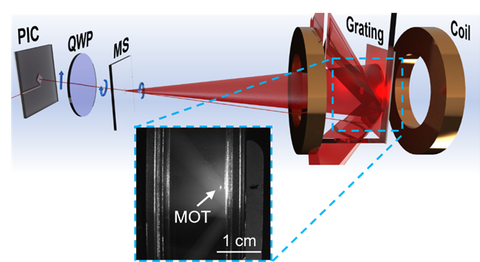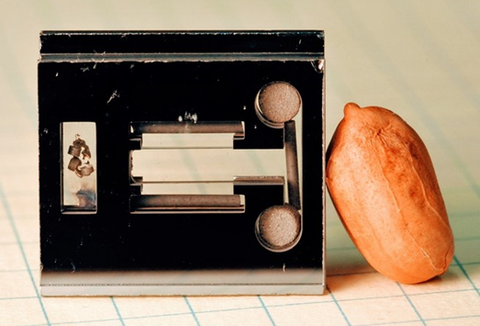Summary
Our research focuses on the development of novel sensing platforms using cold atomic gases and atomic beams. Laboratory-scale cold atom apparatuses provide some of the most precise and accurate measurements for timing and inertial sensing. Our team develops technology to translate this performance from the optics bench to compact devices through research in vacuum technology, integrated optics, and novel probing schemes for cold atoms.
Description
Chip-scale laser cooling

This project develops technologies to achieve chip-scale laser cooling, beyond direct miniaturization of existing laboratory techniques. This includes development of the vacuum technology for realizing low power, passively pumped ultra-high vacuum chambers [1,2] and novel methods to produce atomic vapors [3]. Optical integration of laser cooling is explored using photonic integrated circuits, optical metasurface, and grating-type magneto-optical traps [2,4].
Publications
[1] A. T. Dellis, V. Shah, E. A. Donley, S. Knappe, and J. Kitching, Low Helium Permeation Cells for Atomic Microsystems Technology, Opt. Lett., OL 41, 2775 (2016).
[2] J. P. McGilligan, K. R. Moore, A. Dellis, G. D. Martinez, E. de Clercq, P. F. Griffin, A. S. Arnold, E. Riis, R. Boudot, and J. Kitching, Laser Cooling in a Chip-Scale Platform, Appl. Phys. Lett. 117, 054001 (2020).
[3] J. P. McGilligan, K. R. Moore, S. Kang, R. Mott, A. Mis, C. Roper, E. A. Donley, and J. Kitching, Dynamic Characterization of an Alkali-Ion Battery as a Source for Laser-Cooled Atoms, Phys. Rev. Applied 13, 044038 (2020).
[4] W. R. McGehee, W. Zhu, D. S. Barker, D. Westly, A. Yulaev, N. Klimov, A. Agrawal, S. Eckel, V. Aksyuk, and J. J. McClelland, Magneto-Optical Trapping Using Planar Optics, New J. Phys. 23, 013021 (2021).
Chip-scale atomic beam clocks

Chip-scale atomic beams are a novel platform for quantum sensing. This project developed the first chip-scale atomic beam devices [1] and is currently exploring miniaturized microwave frequency standards based on optical coherent population trapping interrogation of atomic beams. This effort works to combine the miniaturization technology developed for chip-scale atomic clocks with the long-term stability typically afforded in atomic beam platforms.
Publication
[1] G. D. Martinez, C. Li, A. Staron, J. Kitching, C. Raman, and W. R. McGehee, A Chip-Scale Atomic Beam Clock, arXiv:2303.11458.
Compact atom interferometry

Atom interferometry offers a high-stability pathway for inertial sensing. This project develops miniaturized gyroscopes using light-pulse atom interferometry of an expanding gas of laser-cooled atoms [1,2]. We probe the balance of miniaturization and performance achievable using cm-scale volumes.
Publications
[1] Y.-J. Chen, A. Hansen, G. W. Hoth, E. Ivanov, B. Pelle, J. Kitching, and E. A. Donley, Single-Source Multiaxis Cold-Atom Interferometer in a Centimeter-Scale Cell, Phys. Rev. Applied 12, 014019 (2019).
[2] Y.-J. Chen, A. Hansen, M. Shuker, R. Boudot, J. Kitching, and E. A. Donley, Robust Inertial Sensing with Point-Source Atom Interferometry for Interferograms Spanning a Partial Period, Opt. Express 28, 34516 (2020).

